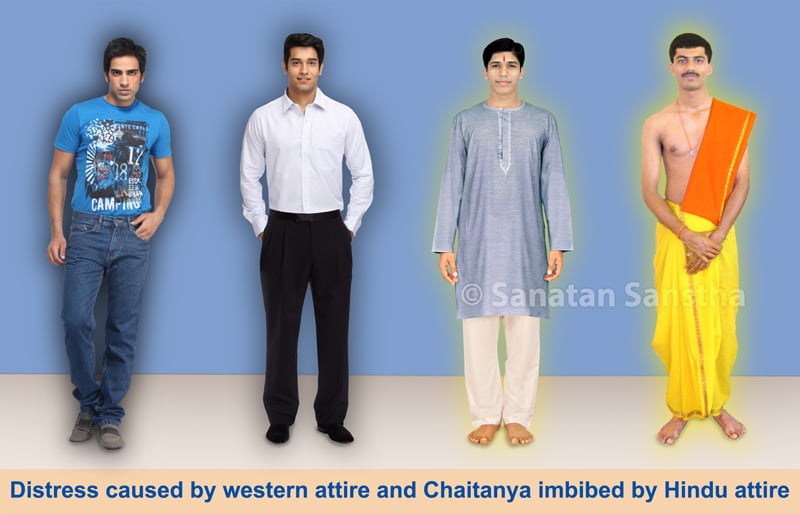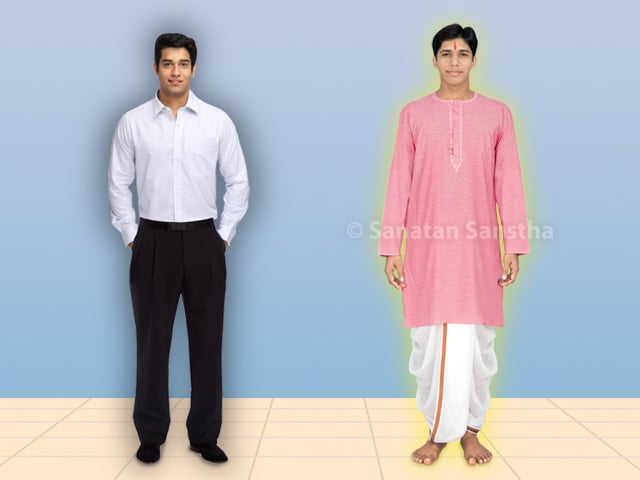1. Introduction to types of attire
Hindu culture is enriched with Chaitanya (Divine consciousness). After studying various types of attire at the gross as well as the subtle levels, that is, by taking into consideration the spiritual perspective, Hindu Dharma has given importance to attires such as sovalē-uparaṇē, dhotī–kurtā. Instead of just thinking superficially about good looks and ease of wearing clothes, comprehensive and in-depth thought has been made by Hindu culture such as enhancing sāttviktā of the wearer, protection from negative energies, ability to imbibe Chaitanya and whether it aids in the efforts for God-realisation. In this article, let us understand spiritual harm caused by western attires like jeans and T-shirt, pant and shirt, and spiritual benefits of Hindu attires like kurtā-dhotī.
2.Types of Attire : Jeans and T-shirt, pant and
shirt / bush shirt, kurtā-pyjāmā, sovalē
and valkal (Attire made from the bark of a tree)
| Types of attire | Jeans and T-shirt | Pant and shirt / bush shirt | Kurtā-pyjāmā | Sovalē | Valkal |
|---|---|---|---|---|---|
| Physical component | Tama-Raja | Raja-Tama | Raja-Sattva | Sattva | Purely Sattva |
| Indicates | Flamboyance | Violent nature | Restraint and courage | Purity | Sanctity |
| Condition of ego | Maximum | High | Medium | Low | Minimal |
| Distress due to negative energies | Extremely severe | Severe | Less | Extremely low | Repels the attacks of negative energies |
2A. Meaningless criticism by the westerners about the use of valkals by Sages:
Criticism : ‘Sages used valkals because they were uncivilized.
Refutation : When compared with all the types of clothing, valkals have the highest proportion of Sattva component. Hence, Sages used valkals. It is thus clear, that the westerners have a rigid mindset about criticizing without understanding the reason and objective of an aspect mentioned in Hindu Dharma.’
2B. Distress caused by western attire and Chaitanya imbibed by Hindu attire
Chaitanya imbibed upon wearing jeans and T-shirt is negligible, upon wearing pant and shirt is minimal, while upon wearing kurtā-pyjāmā is greater; however, upon wearing sovalē it becomes easier to imbibe tārak (Saviour)-mārak (Destroyer) tattva (Principle) and saguṇ (Materialised)-nirguṇ (Non-materialised) tattva of Deities. Kurtā-pyjāmā is at a level between dhotī-kurtā and pant and shirt.
2B 1. Jeans and T-shirt
Upon wearing these clothes, distressing zigzag vibrations are generated that lead to creation of a subtle attraction-oriented covering around the body of the individual. As a result, distressing energy in the atmosphere gets attracted towards the individual.
2B 2. Pant and shirt / bush shirt
Upon wearing these clothes, a continuously moving subtle-covering of dense waves forms around the individual. As a result, Raja-Tama particles in the atmosphere are attracted to the individual, hence, the individual is able to imbibe negligible amount of Divine waves.
2B 3. Kurtā-pyjāmā
Upon wearing these clothes, an oval (Like the flame of an oil lamp) sheath is created around the body. As a result, the individual finds it easier to imbibe Chaitanya from the atmosphere and overcome the Raja-Tama components.
2B 4. Sovalē
A sovalē is more sāttvik than kurtā-pyjāmā. Upon wearing a sovalē, a subtle circular sheath is created around the body of the individual. As a result, the individual finds it easier to imbibe the tārak-mārak tattva and saguṇ-nirguṇ tattva of the Deity.’
3. Types of attire and difference between pant and shirt / bush shirt, and dhotī-kurtā
| Pant and shirt | Dhotī-kurtā | |
|---|---|---|
| Type of thread used | Synthetic | Natural (Cotton, silk) |
| Ability | Ability to absorb and retain the Tama-predominant heat generating waves in the universe | Ability to absorb and retain the Bhūmi (Earth) waves as well as the waves imparting a cooling effect in the universe. |
| Medium of manufacture | Machine. Since a machine is inanimate, it helps create the same sanskār (Subconscious impression) of inanimate nature on the cloth. Therefore, the behaviour of an individual who wears clothes made from such cloth also becomes artificial to an extent | Charkhā (Spinning wheel) or handloom. Handmade thread gives greater benefit. Additionally, if the thread is prepared by a seeker who chants continuously, then the sanskār of the Name (of God) is also created on the thread, and this helps in making the clothes equally sāttvik (Note 1) |
| Nature of the sheath created around the body of the individual through the emitted waves | A mesh-like sheath of swift Tama particles was created | A circular sheath of slowly moving Sattva particles was created |
| Effect on the sheath due to the style of attire | Use of synthetic articles such as hooks and buttons repeatedly disrupt the movement of waves in the sheath | Note 2 |
Note 1 – In the earlier times, cloth was made with the help of charkhā or handloom. In the modern times, use of charkhā is extremely limited. The cloth used for making dhotī-kurtā is also manufactured with machines.
Note 2 – Since the dhotī is tucked in at the waist and wrapped around the body, flow of waves emitting from the dhotī are continuous and swift. It makes this sheath impregnable when compared with the other types of attire. Absence of synthetic articles retains the natural character of the attire and helps in retaining sāttviktā. In the earlier times, buttons of the kurtā were also made of cotton; they were relatively more sāttvik.
4. Wearing a pant, dhotī, sovalē,
pītāmbar (Yellow silk dhotī) while performing pūjā
| Performing pūjā wearing a pant | Performing pūjā wearing dhotī, sovalē, pītāmbar | |
|---|---|---|
| Awakening of bhāv (Spiritual emotion) | Since the required environment is not generated, importance of the pūjā is not impressed upon the mind, leading to delayed awakening of bhāv | Wearing these clothes impresses the sanctity and sāttviktā of the pūjā on the mind, leading to realisation of the seriousness of the pūjā and generation of a conducive environment that helps in early awakening of bhāv |
| Benefits obtained by the individual | Since the fabric used for the pant is made of either synthetic threads such as nylon, rayon or synthetic threads woven with cotton, their ability to imbibe Chaitanya from the Deity is less and ability to retain Raja-Tama is greater. Therefore, benefit of Chaitanya that the individual obtains is less | Since dhotī, sovalē, pītāmbar are made of cotton or silk threads, their ability to imbibe Chaitanya and retain Sattva particles is greater and hence, benefit of Chaitanya that the individual obtains is greater |
| Sanskār | Developing sanskārs of the western culture | Developing sanskārs of customs and traditions in Hindu Dharma |
| Emission of waves and their effect | Emission of Raja-Tama predominant waves leads to creation of a sheath of Raja-Tama predominant waves around the body. As an effect of this sheath, the individual becomes irritable as well as rājasik and tāmasik in nature | Imbibing and emission of sāttvik waves creates a sheath of Sattva particles around the body. As a result, the mind remains blissful, gets the satisfaction of performing the pūjā and the individual becomes sāttvik |
| Ability to attract Bhūmi waves | Lesser | Greater |
| Distress due to negative energies | Due to the ability to retain Raja-Tama particles, negative energies are attracted quickly and hence, greater possibility of increase in distress | Due to the ability to retain Sattva particles and emit sāttvik waves, possibility of distress due to negative energies is minimal |
5. Subtle-effects on men of
wearing pant-coat (Suit), pant-shirt,
‘full-sleeves kurtā-pyjāmā’ and ‘half-sleeves kurtā-dhotī’
All numbers in the table given ahead denote percentages
| Pant-coat (Suit) | Pant-shirt | Full-sleeves kurtā-pyjāmā | Half-sleeves kurtā-dhotī | |
|---|---|---|---|---|
| Shaktī | – | – | 3 | – |
| Chaitanya | – | – | 2 | 3 |
| Ānand | – | – | – | 3 |
| Deity’s Principle | – | – | – | 1.5 |
| Ego | 2.8 | 2 | – | – |
| Negative Energy A. Distressing energy B. Black energy C. Ākarshan-shakti (Attraction energy) D. Māyāvi-shaktī (Illusion creating energy) |
3 2.7 –
3 |
3 3 2.5
– |
– – –
– |
– – –
– |
| Physical and Psychological effect | Due to the Māyāvi-shaktī in them, the individual is pleased and he develops ego that, ‘I look handsome’, and he remains entangled in Māyā (Great Illusion) | Uneasiness increases, as a result of which the individual becomes unstable from the physical and spiritual perspective | The individual is able to remain physically stable and extent of thoughts is less | The mind remains peaceful and hence, the individual is able to remain physically and psychologically Stable |
| Spiritual effect | Distressing vibrations are generated due to the clothes, having a harmful effect on the Shatachakrās (Six Kunḍalinī-chakrās) | Distressing vibrations are generated due to the clothes, creating a possibility of harmful effect on the Shatachakrās | The Shatachakrās remain normal due to these clothes | The Shatachakrās become stable due to these clothes |
5A. Wearing pant-shirt
-
Distressing energy is generated in the pant-shirt depending on its quality, shape and the ego generated in men upon wearing it.
-
Proportion of distressing energy is more since the material of such clothes is either polyester, nylon or acrylic. In contrast, if it is made of cotton, then, Chaitanya is generated in it to some extent because cotton cloth is sāttvik in nature.
5B. Wearing full-sleeves kurtā-pyjāmā
-
In comparison to ‘half-sleeves kurtā-dhotī’ the sāttviktā of ‘full-sleeves kurtā-pyjāmā’ is less by 1.5%; because the cloth used for dhotī is not stitched at any place, meaning, it is a continuous cloth and the cloth used for pyjāmā is cut and stitched.
-
If both that is the full-sleeves kurtā and pyjāmā are white in colour then, it contains 1% more Chaitanya.
5C. Wearing half-sleeves kurtā-dhotī
-
The mind and the intellect both are purified due to this attire.
-
The effect of the Chaitanya in these clothes is also seen on the people who come into contact with the individual wearing these clothes.
-
Chaitanya is created around the body of the individual due to the folds generated in the pleats of dhotī towards the front and the folded dhotī at the back. Also, the individual is protected from the Raja-Tama-predominant vibrations generated from the body and feet. The covering of distressing energy around the body reduces, and the individual is protected from the negative energies coming from Pātāl (Hell region).
-
The spiritual experiences obtained by such an individual are of the nirguṇ
Reference: Sanatan Sanstha’s Holy Text ‘Spiritually beneficial clothes for men’




